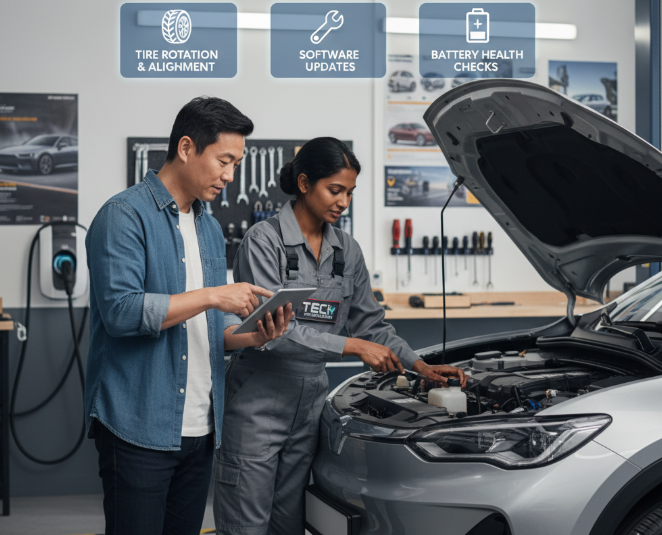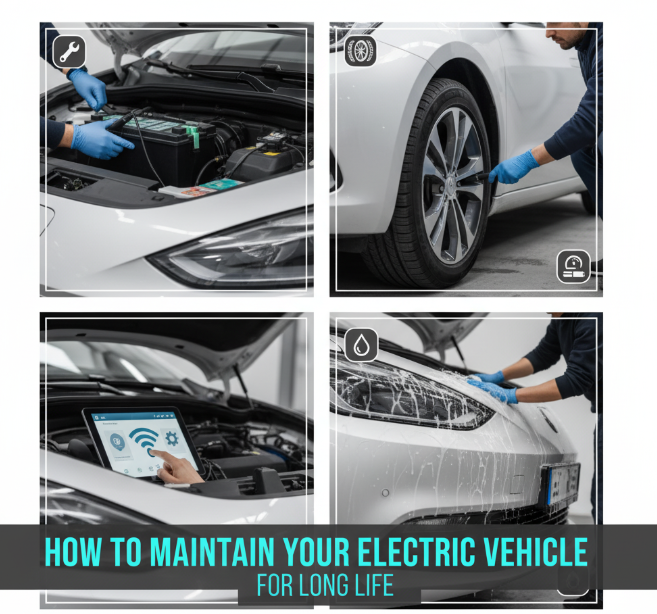Introduction
Buying an electric vehicle (EV) is not just a purchase—it’s an investment in cleaner technology, reduced fuel costs, and a smarter driving future. But like any vehicle, EVs need proper care if you want them to last long and perform efficiently. While EVs have fewer moving parts compared to gas-powered cars, regular maintenance is still essential. Taking small, consistent steps today can save you from expensive repairs later and extend the lifespan of your EV’s battery, motor, and overall system.
In this guide, we’ll cover practical tips, step-by-step care routines, and expert-backed advice to help you keep your electric car in top shape for years.
Why Proper EV Maintenance Matters
- Protects your battery health – the most expensive part of an EV.
- Boosts driving range – ensuring you get the most out of every charge.
- Reduces long-term costs – by preventing expensive breakdowns.
- Improves resale value – a well-maintained EV attracts higher offers.
- Increases safety – keeping brakes, tires, and electronics reliable.
Battery Care: The Heart of Your EV
The battery pack is like the “engine” of your electric car. Since it can cost 30–50% of the vehicle’s total value, it deserves the most attention.
1. Smart Charging Habits
- Avoid 100% charging daily. Keep the battery between 20%–80% for everyday use.
- Use DC fast charging sparingly. While it’s convenient, frequent use can heat the battery and shorten its life.
- Charge overnight at home. A Level 2 home charger with a timer is the safest choice.
📊 Battery health study (approximate data)
| Charging Method | Battery Lifespan Impact |
|---|---|
| Frequent Fast Charging | Shortens by 15–20% |
| 20–80% Routine Charging | Extends life by 25–30% |
| Keeping at 100% Often | Shortens by 10–15% |
2. Temperature Control
- Park in the shade during hot summers.
- Use preconditioning to warm/cool the car while plugged in, not from the battery.
- Avoid exposing the battery to extreme cold for long periods.
3. Regular Battery Health Checks
Most EVs display a battery health report. Check this once every few months to monitor capacity and spot early issues.
Tire and Wheel Maintenance
EVs are heavier than gasoline cars because of their large battery packs, which means tires wear faster.
Tips for Longer Tire Life
- Rotate tires every 6,000–8,000 miles.
- Check tire pressure monthly. Underinflated tires reduce range.
- Use EV-specific tires. They’re designed for high torque and weight.
⚡ Pro Tip: Properly inflated tires can improve driving range by 5–10%.
Brake System Care
EVs use regenerative braking, which reduces wear on brake pads. But don’t ignore them completely.
- Inspect brake pads every 12,000 miles.
- Flush brake fluid every 2–3 years.
- If you hear grinding noises, service immediately.
Cooling and Fluid Systems
Unlike gas cars, EVs don’t need oil changes, but they do require coolant maintenance.
- Battery coolant should be checked every 3–5 years.
- Windshield washer fluid should be topped up regularly.
- Cabin air filters must be replaced every 12–15 months for fresh airflow.
📌 Note: EVs may still need transmission fluid checks (depends on the model).
Charging Port and Cable Care
Your EV’s charging port is like the “fuel tank.” Keeping it clean and safe ensures smooth charging.
- Inspect the charging port monthly. Look for dirt, rust, or loose connections.
- Store charging cables properly. Don’t leave them exposed to rain or heat.
- Avoid yanking the cord. Always unplug gently to prevent connector damage.
Software and Firmware Updates
Modern EVs are computers on wheels. Automakers release updates that:
- Improve range efficiency.
- Add safety features.
- Fix bugs and glitches.
📱 Always connect your car to Wi-Fi at home so it can automatically download updates.
Cabin and Interior Care
Since EV interiors are often high-tech, keeping them clean and safe makes driving more enjoyable.
- Clean touchscreen displays with microfiber cloths.
- Vacuum carpets to prevent dirt from entering cooling vents.
- Check seat heaters and AC performance regularly.
Seasonal EV Maintenance
Summer
- Use eco-driving modes to reduce heat strain on the battery.
- Keep the AC filter clean for efficient cooling.
Winter
- Preheat while plugged in instead of draining the battery.
- Keep the state of charge above 30% in freezing conditions.
- Use winter tires for better grip.
Daily, Monthly, and Yearly Checklist
Daily Care
- Monitor battery level (avoid 0% or 100%).
- Check dashboard alerts.
- Keep car clean.
Monthly Care
- Inspect tire pressure.
- Clean charging port.
- Test brakes and lights.
Yearly Care
- Rotate tires.
- Replace cabin air filter.
- Schedule a professional EV health inspection.
📋 Quick Reference Table
| Maintenance Task | Frequency |
|---|---|
| Tire Rotation | 6,000–8,000 miles |
| Brake Pad Check | 12,000 miles |
| Cabin Air Filter | 12–15 months |
| Coolant System Check | 3–5 years |
| Battery Health Report | Every few months |
Driving Habits That Extend EV Life
Your driving style plays a huge role in how long your EV lasts.
- Avoid rapid acceleration unless necessary.
- Use regenerative braking to preserve brake pads.
- Plan routes efficiently to reduce stress on the battery.
- Drive at moderate speeds to conserve energy.
📊 Driving Speed vs. Battery Range (example data)
| Average Speed (mph) | Range Retained (%) |
|---|---|
| 40 mph | 95% |
| 65 mph | 85% |
| 80 mph | 70% |
Common Mistakes EV Owners Should Avoid
- Leaving the car plugged in at 100% all the time.
- Ignoring software updates.
- Using non-certified charging cables.
- Skipping tire rotations.
- Storing the car with an empty battery for weeks.

Long-Term Storage Tips
If you’re not using your EV for a while:
- Keep the battery at 50–60%.
- Park in a cool, dry garage.
- Unplug the car but check it monthly.
- Cover the EV to protect from dust and sunlight.
Cost Benefits of Regular EV Maintenance
While EVs are cheaper to maintain overall, proactive care saves even more money.
💰 Estimated Annual Maintenance Costs
| Vehicle Type | Average Annual Cost |
|---|---|
| Gasoline Car | $1,200–$1,500 |
| Hybrid Car | $900–$1,200 |
| Electric Car (EV) | $400–$700 |
Future-Proofing Your EV
With EV technology evolving fast, here’s how to keep your car valuable and updated:
- Install a home charger compatible with future models.
- Stay updated with manufacturer recalls.
- Keep a maintenance record for resale purposes.
Conclusion
Maintaining an electric vehicle isn’t complicated—it’s about being consistent. By taking care of your battery, tires, brakes, software, and charging system, you can extend your EV’s life by years. Small habits like keeping your battery between 20–80%, rotating tires, and updating software regularly can make a huge difference.
An EV already saves you money compared to a gas car, but with proper care, it becomes an even smarter investment. Think of maintenance not as a burden but as a way to ensure long-term performance, safety, and value.
👉 Whether you’re a new EV owner or have been driving electric for years, following these maintenance tips will help you enjoy a smooth, reliable, and cost-efficient driving experience well into the future.

Leave a Reply